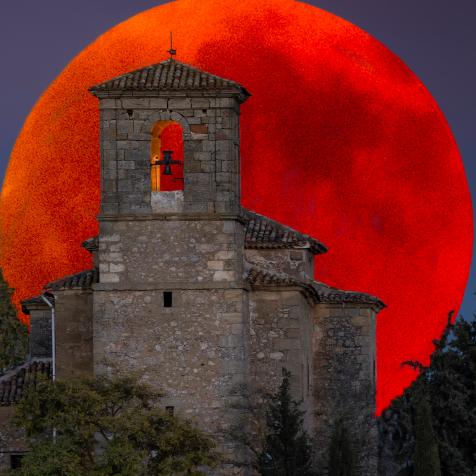
NASA
The Top 5 Weirdest Moons of the Solar System

From the exotic to the just plain odd, our solar system is home to some of the most extreme worlds in the galaxy. But I’m not talking about the planets, I’m talking about their moons. Let’s take a look at the most strange...
5. Pan
This innermost moon of Saturn orbits just about 130,000 kilometers away from the ringed giant, and it wasn’t discovered until 1990 when astronomers re-analyzed old Voyager II data. As moons go it isn’t all that big, just 35 kilometers across and 23 kilometers wide – just big enough to hold Manhattan (although the views would be fantastic). It’s also shaped like a dumpling. Or a Pierogi. Or a ravioli. Or whatever filled-pasta-based food you like best.

NASA/JPL-Caltech/Space Science Institute
This image from NASA's Cassini spacecraft shows how the spacecraft's perspective changed as it passed within 15,300 miles (24,600 kilometers) of Saturn's moon Pan on March 7, 2017. This was Cassini's closest-ever encounter with Pan, improving the level of detail seen on the little moon by a factor of eight over previous observations.
Astronomers think that Pan got its curious shape due to its position within a gap of Saturn’s rings. Pan, like its mythological name suggests, “shepherds” ring material, creating a gap and keeping the rest of the ring in line. In the process, it’s managed to collect for itself a little belt of ices.
And it looks dang tasty.
4. Europa
The second moon of Jupiter looks only mildly interesting on the surface. At least it’s not another boring, rocky, crater-infested airless dead world like so many other moons of the solar system, so it has that going for it. Instead, its surface is coated entirely by a shell of thick water ice, cross-crossed with cracks and grooves.

NASA/JPL/Ted Stryk
Complex and beautiful patterns adorn the icy surface of Jupiter's moon Europa, as seen in this color image intended to approximate how the satellite might appear to the human eye. The data used to create this view were acquired by NASA's Galileo spacecraft in 1995 and 1998.
But what makes Europa really stand out is that the icy shell is just that: a shell. Under a hundred miles of rock-hard ice sits a vast liquid water ocean, girdling the entire moon, reaching down to a depth of more than 50 kilometers.
Europa is home to more liquid water than the Earth. If there’s a chance for life in the solar system other than our home planet, my money’s on Europa.
3. Charon
Charon is the largest natural satellite of Pluto, and stands on its own as the sixth-largest member of all the objects beyond the orbit of Neptune. And while we can debate all day long whether Pluto is a planet or not, we certainly all agree that Charon is impressive.

NASA/JHUAPL/SwRI
Charon in Enhanced Color NASA's New Horizons captured this high-resolution enhanced color view of Charon just before closest approach on July 14, 2015. The image combines blue, red and infrared images taken by the spacecraft’s Ralph/Multispectral Visual Imaging Camera (MVIC); the colors are processed to best highlight the variation of surface properties across Charon.
Charon is half the diameter (though only 1/8th the mass) of Pluto. It’s so big that it tugs on Pluto to such a degree that the barycenter (a fancy physics term that refers to the balance point between two worlds, like the center of a see-saw) sits outside Pluto itself. So it’s not like Charon orbits Pluto. It’s more like Charon and Pluto orbit a common center. That’s pretty impressive…for a moon.
2. Titan
The largest moon of Saturn is shrouded in a thick, hazy atmosphere – an atmosphere even thicker than Earth’s. And underneath those hazy skies we find a rich system of lakes, rivers, streams, and more.

NASA/JPL-Caltech/Space Science Institute
NASA’s Cassini spacecraft snapped this image on Sept. 11, 2011 and it was released on December 22, 2011.
But not of water, but liquid methane.
At a temperature of less than 200 degrees below zero, it’s far too cold for water to stay liquid out here. But methane is totally happy, and Titan is the only world in the solar system, other than our dear old Earth, to host liquids of any kind on its surface.
1. The Moon
That’s right: the Moon. Our Moon. Besides the only moon in the solar system to be visited by humans, the Moon really stands out in the solar system.

NASA/Goddard Space Flight Center/Arizona State University
The near side of Earth's Moon, as seen using data from cameras aboard NASA's robotic Lunar Reconnaissance Orbiter spacecraft.
Check this out. Mercury? No moons. Venus? No moons. Mars? Technically two moons, but those are really just captured asteroids and don’t count.
Earth is the only inner rocky planet to host a moon, and it’s a big one. Besides the Pluto-Charon system, it’s the largest moon in proportion to its host planet. Scientists think that we got our moon when a giant Mars-sized planet crashed into the Earth when it was still forming, sending chunks of that collision into orbit.
Besides its fascinating history, the Moon is also responsible for half the tides on the Earth, helping to keep our axial tilt (and seasons) stable, and allowing us to get those spectacular solar eclipses. Plus, it’s a great place to visit.
Extreme Moons of the Solar System 8 Photos
The solar system is home to over 200 moons. Earth, Mars, Jupiter, Saturn, Uranus, Neptune, and Pluto each have these natural satellites. Let's explore the most strangest ones.




















